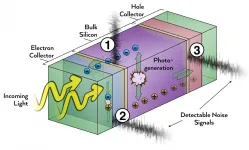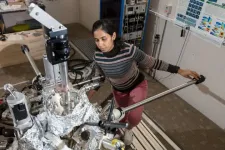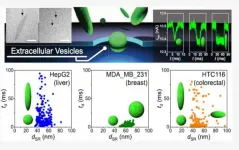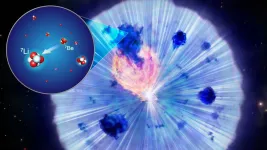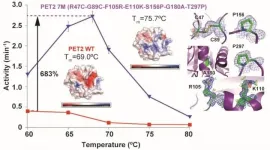(Press-News.org) Some exceptionally gifted people have marked human history and culture. Leonardo, Mozart, and Einstein are some famous examples of this phenomenon.
Is talent in a given field a uniquely human phenomenon? We do not know whether gifted bees or elephants exist, just to name a few species, but now there is evidence that talent in a specific field exists, in at least one non-human species: the dog.
A new study, just published in Scientific Reports, found that, while the vast majority of dogs struggle to learn object labels (such as the names of their toys), when tested in strictly controlled conditions, a handful of gifted word learner dogs learn multiple toy names, apparently effortlessly.
A team of researchers of the Family Dog Project at the Department of Ethology, Eötvös Loránd University, Budapest, exposed 40 dogs to an intensive, three-month-long training program aimed at teaching them the name of at least two dog toys - which is the minimum amount necessary to be able to assess whether dogs can tell the items apart based on their names. The training protocol included daily playful interactions between the dog and the owner, during which the owner repeated the name of the toy several times, and weekly sessions including also a dog trainer.
Video abstract of the study: https://youtu.be/WF6ZpjdH2Sc
"At first, we hypothesized that developmental factors, such as neuroplasticity during puppyhood, would have played a role in making puppies learn object names at a faster rate, compared to adult dogs. Thus, we recruited for this study puppies and adults", reports Dr. Claudia Fugazza, leading researcher of this project. "We were surprised to find that, despite the intensive training, most dogs, irrespective of their age, did not show any evidence of learning. Even more surprisingly, 7 adult dogs showed an exceptional learning capacity: they did not only learn the two toy names but, within the time of the study, they learned between 11 and 37 other novel toy names", continues the researcher.
Among these 7 dogs, 6 already possessed a vocabulary of toy names when the study began; The seventh dog, named Oliva, did not previously know toy names, but learned 21 in only two months, keeping the pace with the other 6 gifted word learner peers. This may suggest that the exceptional capacity to learn object names does not necessarily presuppose prior experience.
"All the 7 dogs that showed this exceptional talent are Border collies, a breed meant to cooperate with humans for herding purposes" reports Shany Dror, co-author of the study, "but it is important to keep in mind that, within the many dogs that did not show any evidence of learning, there were also 18 Border collies".
Moreover, in the literature, some dogs of other breeds are reported to have acquired vocabulary knowledge. For example, a previous study found this capacity in a Yorkshire terrier. Although it may increase the chances, being a Border collie is not necessary, nor enough to be a "gifted word learner dog".
"We are intrigued by this extreme inter-individual variation in a cognitive trait (the capacity to learn object labels) and we think that this is just the beginning of a journey that will lead us to better understand the roots of talent - i.e., why some individuals - humans or other species - are gifted in a given field" concludes Dr. Adam Miklósi, head of the Department of Ethology and coauthor of the study, who thinks that dogs, thanks to their evolution and development in the human environment, constitute the ideal model species to take up the challenge to study the origins of talent and variation across individuals in cognitive capacities.
Once again, the dog, our best friend, may teach us some lessons about ourselves as well.
To recruit more of these rare, gifted word learner dogs for their studies, the researchers of the Eötvös Loránd University have also launched the Genius Dog Challenge http://geniusdogchallenge.com a project that already became viral in the social media, like YouTube https://www.youtube.com/channel/UCDvr5quzSS8xmOPOHzMokjA
INFORMATION:
As society moves towards a renewable energy future, it's crucial that solar panels convert light into electricity as efficiently as possible. Some state-of-the-art solar cells are close to the theoretical maximum of efficiency--and physicists from the University of Utah and Helmholtz-Zentrum Berlin have figured out a way to make them even better.
In a new study, physicists used a technique known as cross-correlation noise spectroscopy to measure miniscule fluctuations in electrical current flowing between materials inside silicon solar cells. The researchers identified crucial electrical ...
Nature has a vast store of medicinal substances. "Over 50 percent of all drugs today are inspired by nature," says Gisbert Schneider, Professor of Computer-Assisted Drug Design at ETH Zurich. Nevertheless, he is convinced that we have tapped only a fraction of the potential of natural products. Together with his team, he has successfully demonstrated how artificial intelligence (AI) methods can be used in a targeted manner to find new pharmaceutical applications for natural products. Furthermore, AI methods are capable of helping to find alternatives to these compounds that have the same effect but are much easier and therefore cheaper to ...
Researchers at the IBS Center for Quantum Nanoscience at Ewha Womans University (QNS) have shown that dysprosium atoms resting on a thin insulating layer of magnesium oxide have magnetic stability over days. In a study published in Nature Communications they have proven that these tiny magnets have extreme robustness against fluctuations in magnetic field and temperature and will flip only when they are bombarded with high energy electrons through the STM-tip.
Using these ultra-stable and yet switchable single-atom magnets, the team has shown atomic-scale control of the magnetic field within ...
Dr Bock, under the mentorship of Distinguished Professor Dietmar Hutmacher, from QUT Centre for Biomedical Technologies, has focused her research on bone metastases from breast and prostate cancers.
She developed 3D miniature bone-like tissue models in which 3D printed biomimetic scaffolds are seeded with patient-derived bone cells and tumour cells to be used as clinical and preclinical drug testing tools.
The research team investigated their hypothesis that traditional anti-androgen therapy had limited effect in the microenvironment of prostate cancer bone tumours. The team's findings are published in Science Advances.
"We wanted to see if the therapy could be a contributor of cancer cells' adaptive responses that fuelled bone ...
A recent study by scientists from Japanese universities has shown that the shape of cell-derived nanoparticles, known as "extracellular vesicles" (EVs), in body fluids could be a biomarker for identifying types of cancer. In the study, the scientists successfully measured the shape distributions of EVs derived from liver, breast, and colorectal cancer cells, showing that the shape distributions differ from one another. The findings were recently published in the journal Analytical Chemistry.
Early detection of cancerous tumors in the body is essential for ...
New York, NY (July 6, 2021) - Mount Sinai researchers have uncovered the complex cellular mechanisms of Ebola virus, which could help explain its severe toll on humans and identify potential pathways to treatment and prevention. In a study published in mBio, the team reported how a protein of the Ebola virus, VP24, interacts with the double-layered membrane of the cell nucleus (known as the nuclear envelope), leading to significant damage to cells along with virus replication and the propagation of disease.
"The Ebola virus is extremely skilled at dodging the body's immune defenses, and in our study we characterize an important way in which that evasion occurs through disruption of the nuclear envelope, mediated by the VP24 protein," says co-senior ...
QUT PhD researcher Zachariah Schuurs said the research team had identified a new binding site on the SARS-CoV-2 spike protein.
"Binding of the CoV-2 spike protein to heparan sulphate (HS) on cell surfaces is generally the first step in a cascade of interactions the virus needs to initiate an infection and enter the cell.
"Most research has focused on understanding how HS interacts on the receptor-binding domain (RBD) and furin cleavage site of the SARS-CoV-2 virus's spike protein, as these typically bind different types of drugs, vaccines and antibodies.
"We have identified a novel binding site on the N-terminal domain (NTD), a different area of the virus's spike that facilitates the binding of HS. This helps to better understand how the virus ...
A new study of lithium production in a classical nova found a production rate of only a couple of percent that seen in other examples. This shows that there is a large diversity within classical novae and implies that nova explosions alone cannot explain the amount of lithium seen in the current Universe. This is an important result for understanding both the explosion mechanism of classical novae and the overall chemical evolution of the Universe.
In the modern world, lithium is used in the rechargeable batteries powering smartphones and other devices. ...
Cheap to produce and long to degrade, plastic was once a manufacturing miracle. Now, plastic is an environmental plague, clogging landfills and choking waterways. A Japan-based research team has turned back to nature to develop an approach to degrading the stubborn substance. Similar to how a protein binds to cellulose in plants or to chitin in crustaceans to initiate decomposition, an engineered protein is on its way to binding to plastic particles in an effort to more efficiently break them down.
They published their results on June 29 in ACS Catalysis, a journal of the American Chemical Society.
"Polyethylene ...
In two recent articles published in Schizophrenia Bulletin, Sharon Hunter, PhD, an associate professor in the University of Colorado School of Medicine Department of Psychiatry, and M. Camille Hoffman, MD, MSc, an associate professor in the University of Colorado School of Medicine Department of Obstetrics and Gynecology, along with their research group, have uncovered a potential link between choline deficiency in Black pregnant women in the United States and increased risk of developmental and behavioral issues that can evolve into mental illness later in their children's lives.
The first article, published in November 2020, is a study, titled, "Black American Maternal Prenatal Choline, Offspring Gestational Age at Birth, and Developmental Predisposition to Mental Illness." The ...

